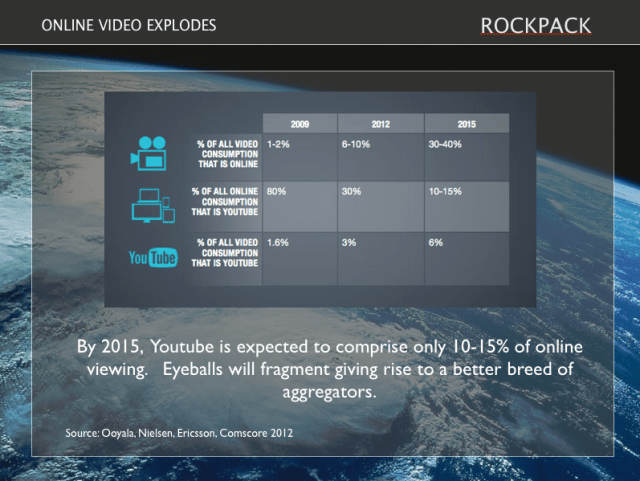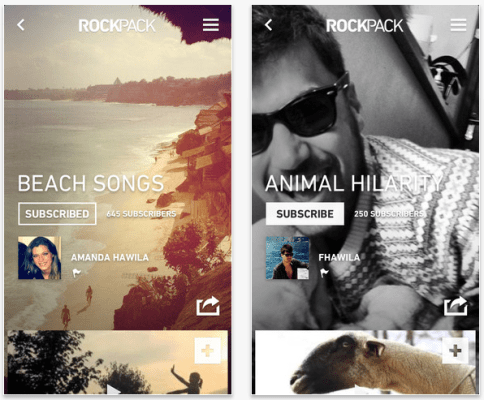Video — as Instagram’s recent launch, Yahoo’s would-be and actual acquisitions, and others’ new content initiatives show — is a hot property today, with more people than ever before consuming video online, and advertisers scrambling to catch that wave. While Google’s YouTube is by far the biggest player in this space, video — like the medium itself — is a moving target that will see a number of new players continue to enter the scene, a long tail that has bred a whole sub-genre of video apps dedicated to video discovery.
The latest of these, London-based Rockpack, is launching today on iOS, with a focus on simplicity, personalization and curation that it believes will help it stand apart from the crowd. Further platforms are soon to come.
Backed with $2 million in seed funding from Qualcomm; the longtime head of Apple in Europe, Pascal Cagni; and others, Rockpack today is also announcing an advisory board that includes Stephen Fry; Jamie Byng, publisher and managing director of Canongate Books; Sean Knapp, co-founder and chief product officer of Ooyala; Elizabeth Sheinkman and Sol Parker of William Morris Endeavor; Matt Heiman, founder of Diagonal Views; Philip DeBevoise, co-founder of Machinima; and Zach Leonard, digital managing director at The Independent Group.
No doubt that Rockpack is entering a crowded field, with noshortage of videodiscovery apps out in the market today (I could have made every one of the words in this sentence a separate link, and each of these in the parenthesis, too). So what is different with Rockpack? Sofia Fenichell, the startup’s founder and CEO sees a lot of what has preceded Rockpack as a feature race, with the end result being services that are too heavy with options.
“We will be different because we are focussed on personalisation. Our user interface is designed to surprise and delight the user. Personalised recommendation, executed well, trumps any algorithm or search engine. That is the joy of discovery. No one else is doing this,” she says.
Rockpack works like this: you use the app to find video content that you would like to watch, which can be on channels that are already on there. You can also create your own channels to save that content and topic. These can then be shared with your contacts, and people in turn can use the app to find these channels. Beyond being a simple way of clipping and bookmarking certain videos, Rockpack also suggests to you other videos that might also fit with what you have already seen, which you can then add to what you’ve already flagged. This is not unlike the idea behind Pinterest’s Pinboards.
The long tail of users will likely end up sharing content like this mainly with their own contacts, but as with other social networks like Twitter, Pinterest and Facebook, there will be popular people — “influencers” if you don’t mind the word (it makes me wince a little, personally) — who will be followed by more wider audiences.
The UK celebrity chef and cheeky chappy Jamie Oliver is a fan and will be using the service to create channels for his food content, as will Stephen Fry and a number of other sites and brands including Goal.com, Universal Music, Stylehaul, Topshop, Asos, Disney, Warner and National Geographic.
The big names signing on are a sign, too, of how Rockpack is looking early on at ways of marketing and monetizing content without resorting directly to preroll, inline and other video formats, although monetization is not something Rockpack is looking to turn on so early in the game.
While the vast majority of content on Rockpack today will be coming from YouTube, longer term the idea is that it will be a place that will aggregate content from multiple networks. Rockpack notes that this is coming at a time when it will become even more imperative for effective ways of discovering content.
Interestingly, as a measure of how fragmented things are already, while YouTube took 30% of all video views online in 2012, when you consider both online and offline together, YouTube accounted for only around 3%. That will grow over time, but proportionately, YouTube’s share of online video views will decline. From Rockpack’s investor slidedeck:

There is another trend in Rockpack’s favor. More often than not in the ever-evolving world of technology, it’s not the case that being the first or even early mover is a sure sign of success. That’s been the case in hardware (think iPhone and Android devices) as well as software.
“Remember there were dozens of photo sharing apps before Instagram. Many RSS readers before Flipboard. And many social networks before Facebook. In fact the oldest social networks that were plagued with issues from the beginning still can’t restructure,” noted Fenichell. “We will succeed because we have put a fresh face on a use case that is just dying to be unlocked. We will succeed also because content providers love our user interface and where content goes, people follow.”
These are tenacious words that you would expect out of any entrepreneur, but what’s interesting about Fenichell is that she’s not your typical startup founder. She’s a mother of two, and this is actually her third career. Before working for and founding tech companies themselves, she started out in advertising. Later, she went to business school and worked for a number of big investment banks — perhaps most intriguingly including a stint as a VP and internet analyst at Merrill Lynch at the same time Henry Blodget made his mark there (another story for another time).
As for the name Rockpack? That story says a lot about the company’s equal measures of ambition and pragmatism: “We wanted a brand name that was strong, distinctive and aspirational,” she notes, adding, “People hang in packs. It’s a platform solid as a rock. And people rock. But truthfully, it was one of the few dot com names that I could find that was a real word and cost less than $1,000.”
